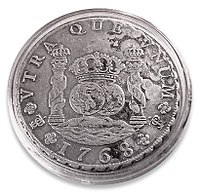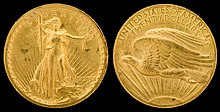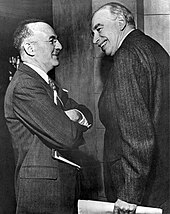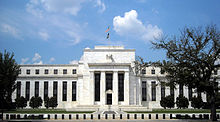United States dollar
U.S. banknotes are issued in the form of Federal Reserve Notes, popularly called greenbacks due to their predominantly green color.[9] Laws implementing this power are currently codified in Title 31 of the U.S. Code, under Section 5112, which prescribes the forms in which the United States dollars should be issued.When currently issued in circulating form, denominations less than or equal to a dollar are emitted as U.S. coins, while denominations greater than or equal to a dollar are emitted as Federal Reserve Notes, disregarding these special cases: In the 16th century, Count Hieronymus Schlick of Bohemia began minting coins known as joachimstalers, named for Joachimstal, the valley in which the silver was mined.In turn, the valley's name is titled after Saint Joachim, whereby thal or tal, a cognate of the English word dale, is German for 'valley.[24] Greenback is another nickname, originally applied specifically to the 19th-century Demand Note dollars, which were printed black and green on the backside, created by Abraham Lincoln to finance the North for the Civil War.The newer designs, with portraits displayed in the main body of the obverse (rather than in cameo insets), upon paper color-coded by denomination, are sometimes referred to as bigface notes or Monopoly money.The sign was perhaps the result of a late 18th-century evolution of the scribal abbreviation ps for the peso, the common name for the Spanish dollars that were in wide circulation in the New World from the 16th to the 19th centuries.This theory, popularized by novelist Ayn Rand in Atlas Shrugged,[34] does not consider the fact that the symbol was already in use before the formation of the United States.The minting of machine-milled Spanish dollars since 1732 boosted its worldwide reputation as a trade coin and positioned it to be the model for the new currency of the United States.[citation needed] Even after the United States Mint commenced issuing coins in 1792, locally minted dollars and cents were less abundant in circulation than Spanish American pesos and reales; hence Spanish, Mexican, and American dollars all remained legal tender in the United States until the Coinage Act of 1857.[36] Alexander Hamilton arrived at these numbers based on a treasury assay of the average fine silver content of a selection of worn Spanish dollars, which came out to be 371 grains.This allowed the value of things to remain fairly constant over time, except for the influx and outflux of gold and silver in the nation's economy.Summary and links to coins issued in the 19th century: In order to finance the War of 1812, Congress authorized the issuance of Treasury Notes, interest-bearing short-term debt that could be used to pay public dues.In 1875, Congress passed the Specie Payment Resumption Act, requiring the Treasury to allow U.S. Notes to be redeemed for gold after January 1, 1879.Despite all links to gold being severed in 1971, the dollar continues to be the world's foremost reserve currency for international trade to this day.It was founded in 1913 under the Federal Reserve Act in order to furnish an elastic currency for the United States and to supervise its banking system, particularly in the aftermath of the Panic of 1907.For most of the post-war period, the U.S. government has financed its own spending by borrowing heavily from the dollar-lubricated global capital markets, in debts denominated in its own currency and at minimal interest rates.This ability to borrow heavily without facing a significant balance of payments crisis has been described as the United States's exorbitant privilege.[55] The dimensions of the modern (small-size) U.S. currency is identical to the size of Philippine peso banknotes issued under United States administration after 1903, which had proven highly successful.These notes were used primarily in inter-bank transactions or by organized crime; it was the latter usage that prompted President Richard Nixon to issue an executive order in 1969 halting their use.As a result of a 2008 decision in an accessibility lawsuit filed by the American Council of the Blind, the Bureau of Engraving and Printing is planning to implement a raised tactile feature in the next redesign of each note, except the $1 and the current version of the $100 bill.It also plans larger, higher-contrast numerals, more color differences, and distribution of currency readers to assist the visually impaired during the transition period.Its primary task is to conduct the nation's monetary policy to promote maximum employment, stable prices, and moderate long-term interest rates in the U.S. economy.The Spanish dollar was later displaced by the British pound sterling in the advent of the international gold standard in the last quarter of the 19th century.The U.S. dollar began to displace the pound sterling as international reserve currency from the 1920s since it emerged from the First World War relatively unscathed and since the United States was a significant recipient of wartime gold inflows.[78] The U.S. dollar is predominantly the standard currency unit in which goods are quoted and traded, and with which payments are settled, in the global commodity markets.In contrast, foreign governments and corporations incapable of raising money in their own local currencies are forced to issue debt denominated in U.S. dollars, along with its consequent higher interest rates and risks of default.[80] The United States's ability to borrow in its own currency without facing a significant balance of payments crisis has been frequently described as its exorbitant privilege.[88] The Federal Reserve, which was established in 1913, was designed to furnish an "elastic" currency subject to "substantial changes of quantity over short periods", which differed significantly from previous forms of high-powered money such as gold, national banknotes, and silver coins.The Federal Reserve, however, continued to increase the money supply, resulting in stagflation and a rapidly declining value of the U.S. dollar in the 1970s.







United States
External adopters of the US dollar
Currencies pegged to the US dollar
Currencies pegged to the US dollar w/ narrow band
Worldwide use of the
euro
:
External adopters of the euro
Currencies pegged to the euro
Currencies pegged to the euro w/ narrow band

USD (disambiguation)Federal Reserve NotesISO 4217SymbolgreenbackspondulixWashingtonsJeffersonsLincolnsHamiltonsJacksonsGrantsBenjaminssawbuckDenominationsProposed, never issuedBanknotes$1,000$5,000$10,000$100,0001⁄2¢Continental currencyPound sterlingSpanish dollarCentral bankFederal ReservePrinterBureau of Engraving and PrintingUnited States MintInflationPegged bycurrency codedollarcurrencyUnited Statesseveral other countriesCoinage Act of 1792Spanish silver dollarmintingbimetallic standardtroy ounceGold Standard Actreserve currencyFirst World WarBretton Woods AgreementSecond World Warinternational transactionsfree-floating currencyde facto currencymonetary policy of the United StatesFederal Reserve SystemtrillionUnited States NotesArticle IU.S. ConstitutionCongresscoin moneyTitle 31U.S. Codelegal tenderSacagawea dollarcopper alloyAmerican Silver Eaglesilverissuanceone centU.S. PennyCoins of the United States dollarunit of accountSpanish milled dollarSpanish realesU.S. CongressCoinage Actgrainsunit of currencyContinental Congressdecimal systemsales taxesgasoline pricesgallonrealesNew York Stock ExchangeSecretary of the TreasuryJames Guthriehalf unionU.S. coinscirculationdouble eagleplatinumpalladium coinsbullionshinplastersHieronymus SchlickBohemiaJoachimstalJoachimGermanSlovakSlovenianDanishSwedishPolishNorwegiantalariEthiopianHungarianItalianArabicEnglishNew YorkreichsthalersleeuwendaaldersSpanish AmericancolloquialismleatherDemand NoteAbraham LincolnCivil WarAustraliaNew ZealandSouth AfricaMonopolyPiastreLouisiana PurchaseCajun French